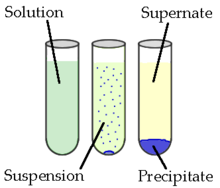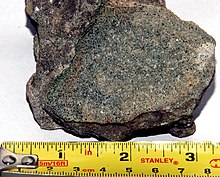Authigenesis
Authigenesis process

The authigenesis process is driven by particles of sediment that are not in
Over time, sediments become more buried by deposition and precipitation. This causes compaction and cementation to occur and decreases porosity farther, changing the control on the authigenesis process from fluid composition to temperature. Increased temperatures around sediments leads to increased reactions in order for the sediment to reach thermodynamic equilibrium with the surroundings. This often is done through dehydration reactions because these reactions have a high entropy release.
Metamorphism
At larger depths, the line between authigenesis and metamorphism is blurred. In metamorphic petrology an authigenic mineral is one formed in situ during metamorphism, again by precipitation from fluids or recrystallization. However, minerals created by temperatures above 250 degrees Celsius are generally agreed upon to not be authigenic minerals, but rather metamorphic minerals.
Common authigenic minerals in sedimentary rocks

- calcium carbonate[1]
- apatite[2]
- clays[3]
- hematite[4]
- limonite[4]
- chamosite[4]
- siderite[4]
- silica[4]
- glauconite[4]
- pyrite[4]
See also
References
- ^ Scott Ritger, Bobb Carson, and Erwin Suess, 1987. Methane-derived authigenic carbonates formed by subduction-induced pore-water expulsion along the Oregon/Washington margin. Geol. Soc.Am. Bull.; 98; 147-156.
- ^ Kathleen C. Ruttenberg and Robert A. Berner, 1993. Authigenic apatite formation and burial in sediments from non-upwelling, continental margin environments. Geochim. Cosmochim. Acta.; 57; 991-1007
- ^ M. D. Wilson and E. D. Pittman, 1977. Authigenic clays in sandstones; recognition and influence on reservoir properties and paleoenvironmental analysis. J. Sed. Res.; 47; 3-31.
- ^ ISBN 0-04-552018-6.)
{{cite book}}: CS1 maint: multiple names: authors list (link
External links
